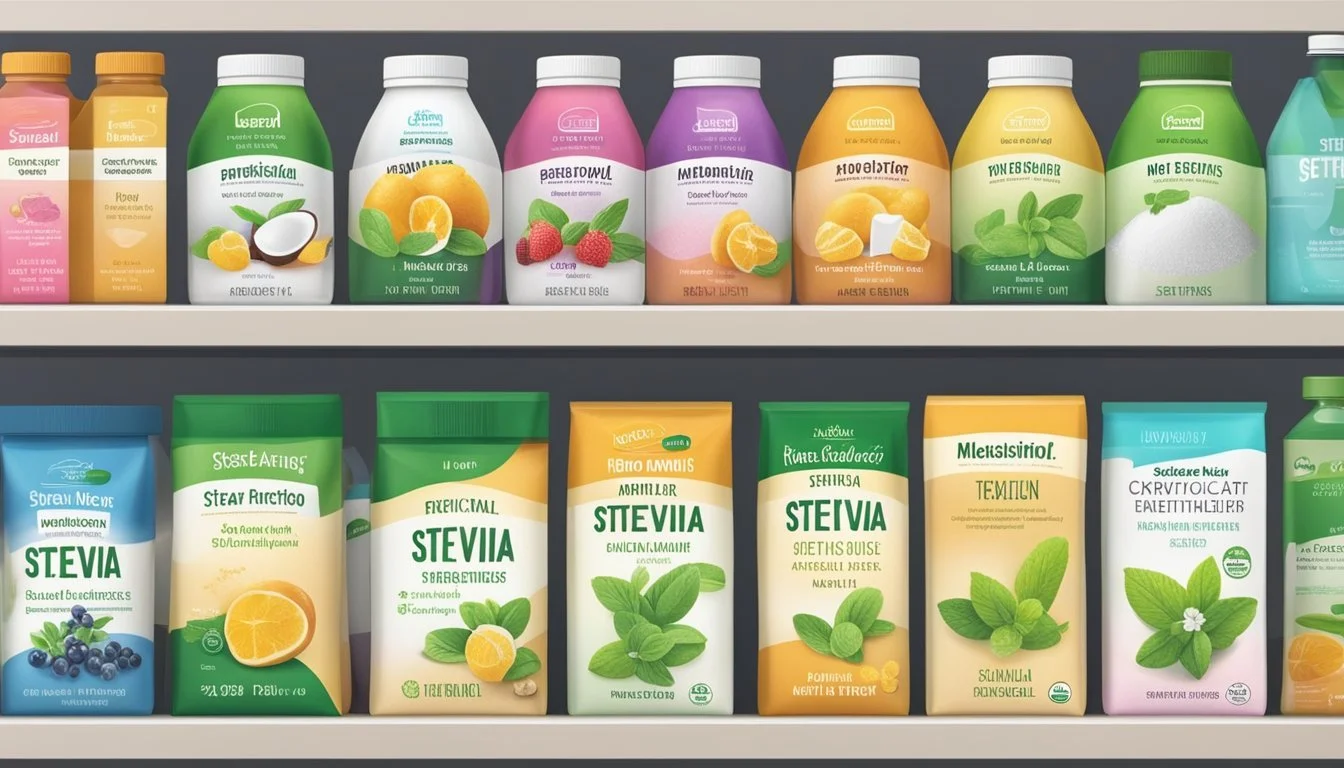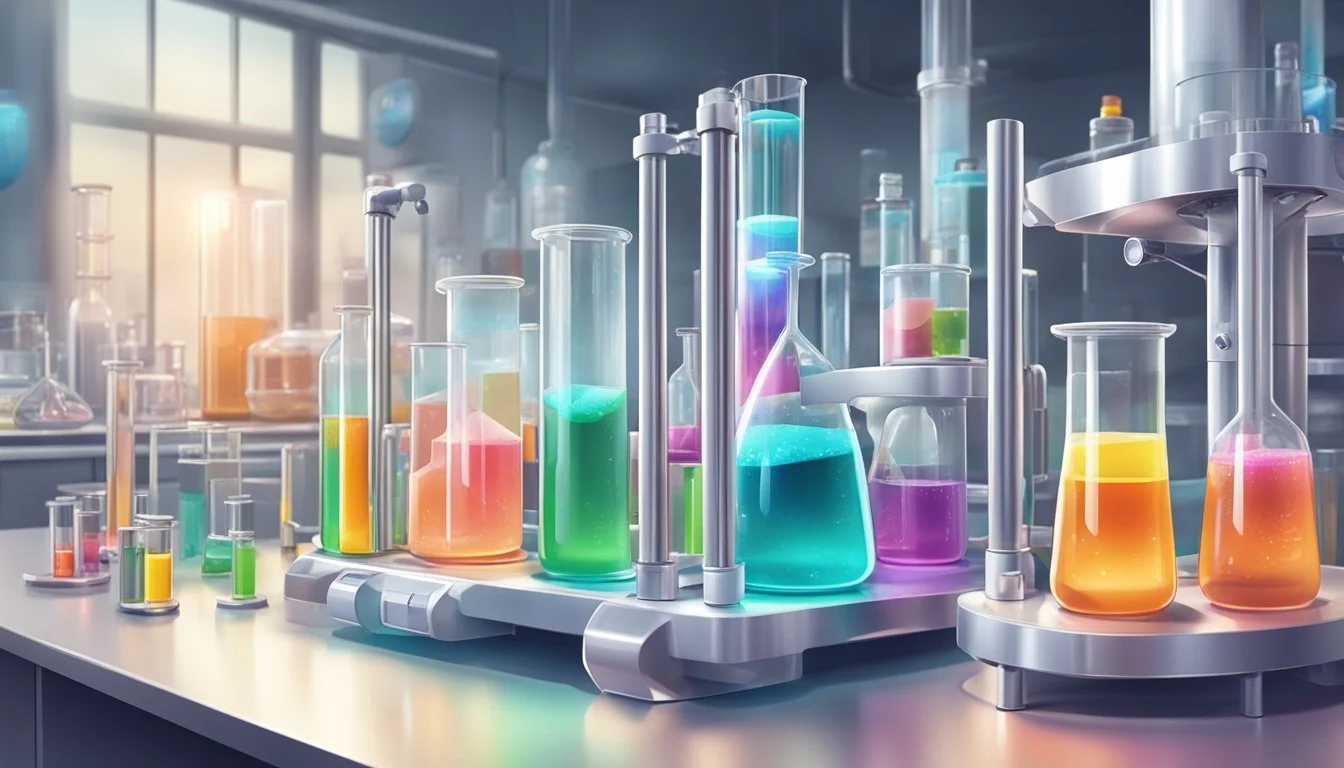Artificial Sweetener Substitutes
Your Guide to Healthier Sugar Alternatives
Artificial sweeteners have emerged as a popular alternative to sugar, catering to those looking to reduce their caloric intake or manage blood sugar levels. These sugar substitutes are synthetic and can be derived from naturally occurring substances, including herbs or sugar itself. They are known for their high intensity of sweetness, often hundreds to thousands of times sweeter than regular sugar, which means they can be used in much smaller quantities. The inclusion of artificial sweeteners in daily diets has become commonplace, found in a variety of products such as beverages, baked goods, and dairy products.
The safety and health implications of artificial sweeteners are subjects of ongoing research and debate within the scientific community. Some studies suggest potential health concerns associated with long-term use, such as an increased risk of stroke, heart disease, and other health complications. Others argue that artificial sweeteners are a safe and effective tool for weight management and diabetes control when used as part of a balanced diet. The Food and Drug Administration (FDA) has approved several artificial sweeteners, including aspartame, saccharin, and sucralose, affirming their safety for the general population when consumed within acceptable daily intake levels.
Consumer attitudes towards artificial sweeteners vary, with some individuals fully embracing them as a diet staple, while others remain cautious due to concerns over possible health risks and questions about their long-term effects. The choice to use artificial sweeteners ultimately depends on individual preferences, health goals, and the advice of healthcare professionals, with a growing body of research helping to inform these decisions.
Understanding Artificial Sweeteners
Artificial sweeteners are chemical compounds used as sugar substitutes to provide sweetness without the calories. They vary in composition and sweetness intensity.
Chemical Structure and Types
Artificial sweeteners are diverse in their chemical structure but are unified by their common purpose: to offer a sweet taste with minimal or no calories. Key types include:
Saccharin: Discovered in the 1870s, it's known for its zero-calorie sweetness.
Aspartame: Composed of amino acids phenylalanine and aspartic acid, it's about 200 times sweeter than sugar.
Sucralose: Made by chlorinating sucrose, it is 600 times sweeter than sugar and withstands heat well.
Stevia: Derived from the Stevia rebaudiana plant, this natural substitute is up to 300 times sweeter than sugar.
Acesulfame Potassium (Ace-K): Often blended with other sweeteners and is 200 times sweeter than sugar.
Neotame: Structurally similar to aspartame but up to 7,000 times sweeter and safe for individuals with phenylketonuria (PKU).
Regulatory Status and Safety
The U.S. Food and Drug Administration (FDA) regulates artificial sweeteners as food additives. The FDA, along with the World Health Organization (WHO), has established an Acceptable Daily Intake (ADI) for each sweetener, reflecting the amount considered safe to consume every day over a lifetime.
Saccharin: Once carried a warning label due to cancer concerns in rats, but this has since been removed based on human studies showing no consistent evidence of cancer risk.
Aspartame: Requires a warning label for individuals with PKU due to its phenylalanine content.
Sucralose: FDA-approved after extensive review; considered safe for all populations.
Stevia: Granted generally recognized as safe (GRAS) status when used as a sweetener.
Acesulfame Potassium: Approved by the FDA and given an ADI after more than 90 studies confirmed its safety.
Neotame: Granted FDA approval in 2002 after thorough safety evaluation.
The FDA and international health agencies assure consumers that within the established ADIs, these sugar substitutes are safe for the general population, including pregnant women and children, when consumed as part of a balanced diet.
Health Considerations
The consumption of artificial sweeteners is often associated with health considerations regarding weight management, diabetes control, cardiovascular health, and impacts on the gut microbiome.
Impact on Weight Management
Artificial sweeteners provide a sweet taste without the calories associated with sugar, which can be appealing for those trying to manage weight. However, evidence suggests that they may not always aid in weight loss. Some studies indicate a potential link between artificial sweeteners and weight gain, as they might not satisfy the appetite as sugar does and could lead to increased overall calorie consumption.
Diabetes and Blood Sugar Control
For individuals with diabetes, artificial sweeteners may offer a way to enjoy sweet foods without significantly raising blood sugar levels. The American Diabetes Association acknowledges their utility in diabetes management, though emphasizes they are to be used in moderation. Nevertheless, the full implications on blood sugar control and insulin response are complex and require further investigation.
Heart Health and Risks
Research, including findings from the American Heart Association and Centers for Disease Control and Prevention, suggests a correlation between high usage of artificial sweeteners and an increased risk of cardiovascular disease, including heart disease and stroke. The causation is not fully established, but it is observed that high consumption might be related to higher rates of these conditions.
Gut Microbiome Effects
Artificial sweeteners have been scrutinized for their effects on the gut microbiome. The impact varies depending on the type and amount consumed, but there is a growing body of research suggesting they can alter the gut bacteria population in ways that might influence metabolism and overall health. Registered dietitians and nutrition experts may caution against over-reliance on these substitutes until more conclusive evidence is available.
Artificial Sweeteners in Foods and Beverages
Artificial sweeteners serve as a widely used alternative to table sugar, offering fewer calories and being utilized in everything from beverages to baked goods. They can influence nutrition and often cater to those seeking sugar-free options.
Common Food Products
Artificial sweeteners are used extensively in a variety of food products. They provide a sweet taste without the calories associated with sugar, making them a popular choice for weight management and for those with certain health concerns, such as diabetes. In baked goods, sweeteners like aspartame and sucralose are often utilized to maintain sweetness while catering to calorie-conscious consumers. Candies and jams frequently contain artificial sweeteners to provide sweetness without additional added sugars. Moreover, products like yogurt, gum, and even cough drops often include these sugar substitutes to enhance flavor while controlling carbohydrate content.
Fruit-flavored candies: Commonly contain sweeteners like aspartame.
Sugar-free jams: Sweetened with substitutes to reduce calorie content.
Chewing gum: Often sugar-free, sweetened with various artificial alternatives.
"Diet" or "light" baked goods: Utilize sugar substitutes to reduce caloric density.
Beverage Industry
In the beverage industry, artificial sweeteners are critical in the formulation of diet soft drinks and other sugar-free beverages. Sweeteners such as sucralose, saccharin, and aspartame allow manufacturers to create sweetened beverages without the glucose and calories found in drinks made with table sugar or high fructose corn syrup. Not only are these sweeteners used in soft drinks, but also in various diet teas, and sports and energy drinks to appeal to consumers looking for low-calorie alternatives. Their usage allows drinks like Crystal Light or Diet Snapple to maintain a pleasant taste while being marketed as sugar-free or low in added sugars.
Soft drinks: Diet sodas commonly use aspartame, saccharin, or sucralose.
Teas: Diet versions are made palatable with the addition of sugar substitutes.
Energy and sports drinks: Often contain artificial sweeteners to reduce sugar content.
Alternatives to Artificial Sweeteners
In response to health concerns and dietary preferences, consumers often seek alternatives to artificial sweeteners. These substitutes aim to provide the sweetness of sugar without the potential risks associated with artificial sweeteners.
Natural Sugar Substitutes
Honey: Collected from the nectar of flowers by bees, honey varies in flavor based on its floral source, but consistently provides a rich sweetness. It contains trace nutrients and antioxidants, although it is similar in calorie content to sugar.
Agave Nectar: Sourced from the agave plant, this sweetener is sweeter than sugar, so less is needed. Agave nectar has a low glycemic index, but high fructose content, which should be considered in dietary planning.
Molasses: This thick syrup is a byproduct of sugar refining. It varies in color and taste depending on the processing stage. Blackstrap molasses, one type, retains minerals like iron and calcium.
Monk Fruit (Luo Han Guo): Native to Southeast Asia, monk fruit sweetener is derived from the fruit’s extract. It contains no calories and is much sweeter than sugar.
Steviol Glycosides (Stevia): Extracted from the leaves of the stevia plant, steviol glycosides provide a calorie-free sweet option. They are much sweeter than sugar and have a minimal effect on blood glucose levels.
Sugar Alcohols and Low-Calorie Options
Sorbitol: Found naturally in some fruits and commercially produced from glucose, sorbitol is less caloric than sugar. It has a slow absorption rate and can have a laxative effect if consumed in large amounts.
Xylitol: Commonly derived from birch wood or other plant material, xylitol resembles sugar in sweetness but contains fewer calories and does not raise blood sugar significantly.
Erythritol: Among the sugar alcohols, erythritol has the lowest calorie content. It's absorbed into the bloodstream before it reaches the colon, reducing the likelihood of digestive distress.
Mannitol: Sourced from sugar cane or sugar beets, Mannitol has a taste profile similar to sugar but with half the calories. It is also used as a medication to decrease high pressures in the eye.
These sweetener options each come with unique profiles in terms of taste, calorie content, and impact on health. Manufacturers and consumers may choose based on such characteristics, striking a balance between sweetness and dietary needs.
Consumer Considerations and Usage
When consumers opt for artificial sweeteners, it's important they understand how to read nutrition labels and know the daily intake recommendations to make informed dietary choices that align with their nutrition and sugar intake goals.
Reading Nutrition Labels
Consumers should carefully examine nutrition labels to assess the presence and amount of artificial sweeteners. These products are often marketed under various brand names such as Splenda (sucralose), Equal (aspartame), Sunett and Sweet One (acesulfame potassium), Truvia (stevia-based), Sweet'N Low (saccharin), Sweet Twin (aspartame), Necta Sweet (saccharin), and Newtame (advantame). Labels might also highlight "no added sugar", which can be instrumental for those monitoring their sugar intake. However, it's critical to note that even if a product has no added sugar, it might still contain calories or other ingredients that could affect one's diet, like protein, fiber, or vitamins.
Nutrition Label Checklist:
Calories: Check for caloric content, even if sugars are absent.
Ingredients: Look for the names of artificial sweeteners in the ingredient list.
Nutritional Information: Assess the presence of other nutrients that contribute to dietary balance.
Daily Intake Recommendations
The U.S. Food and Drug Administration (FDA) has established acceptable daily intake (ADI) levels for each sweetener, which is the maximum amount considered safe to consume each day over the course of a lifetime. Consumers with specific dietary conditions, like phenylketonuria (PKU), should avoid aspartame, found in brands like Equal and NutraSweet, as it contains phenylalanine. For consumers without health conditions influencing their sweetener intake, it is generally considered safe to consume these sweeteners within the FDA's ADI guidelines, which varies for each sweetener:
Aspartame: 50 mg/kg body weight
Saccharin: 15 mg/kg body weight
Sucralose (Splenda): 5 mg/kg body weight
Acesulfame Potassium: 15 mg/kg body weight
Steviol Glycosides (Truvia): 4 mg/kg body weight
People with a sweet tooth or those experiencing cravings might find these sweeteners useful to stay within their daily sugar allowances. Still, consumers should aim for a balanced diet that satisfies all nutritional needs while accounting for their intake of artificial sweeteners.
Controversies and Debates
Artificial sweetener substitutes have been the center of various health-related controversies, with debates primarily focusing on their potential links to cancer and their behavioral and psychological impacts.
Cancer and Disease Correlations
Research regarding artificial sweeteners and cancer has produced conflicting results. Some studies suggest a possible correlation between artificial sweeteners and an increased risk of cancer, with particular concern over bladder cancer. However, the National Cancer Institute maintains that there is no clear evidence that artificial sweetener consumption in humans poses a cancer risk. Health risks are a point of contention, as some researchers argue that artificial sweeteners may be associated with an increased risk of heart attack and stroke, although definitive evidence is lacking.
Obesity: While some studies suggest that artificial sweeteners may help with weight loss, others indicate that they may contribute to weight gain, potentially leading to obesity.
Prediabetes: There is also a debate over whether artificial sweeteners may influence the development of prediabetes, with some evidence suggesting they might disrupt the body's ability to control blood sugar levels.
Behavioral and Psychological Effects
Artificial sweeteners are often scrutinized for their potential behavioral and psychological effects. Critics, including organizations like the Center for Science in the Public Interest (CSPI), argue that these sugar substitutes may lead to cravings for sweeter, less healthy foods, thus undermining their value in weight loss efforts. The psychological impact revolves around how consumption of artificially sweetened products might alter taste preferences, potentially increasing an individual's desire for sweet foods and drinks.
Taste Preferences: Regular consumption of artificial sweeteners may lead to a higher threshold for sweetness, thus requiring more sugar to achieve the desired taste sensation.
Appetite Control: There is ongoing research to determine if artificial sweeteners disrupt the body's mechanisms for appetite control, which could indirectly contribute to health risks such as obesity.
Environmental and Economic Impact
The production and distribution of artificial sweetener substitutes hold significant consequences for both the environment and the economy. They reflect a complex interplay between industrial demand, environmental stewardship, and economic trends.
Production and Manufacturing
The manufacturing process of artificial sweeteners involves several chemical syntheses and purification stages that take place in industrial laboratories. Substances such as saccharin and sucralose are synthesized through complex chemical reactions, which necessitate the use of various raw materials and energy. The environmental footprint of producing these sweeteners includes the emission of greenhouse gases, the generation of chemical waste, and the potential for water pollution. Some artificial sweeteners, due to their stable chemical structure, do not break down easily in the environment, leading to accumulation in water bodies.
The economic aspect looks at the cost of raw materials, labor, and technology required to produce sweeteners. Manufacturers strive to optimize production efficiency and reduce costs to remain competitive in the market, which has a direct impact on the industry's economic health.
Market Dynamics
The market for artificial sweeteners is influenced by consumer demand for low-calorie alternatives to sugar. It is also shaped by public health policies aimed at combating obesity and diabetes. Here are some specific aspects of the market dynamics for artificial sweeteners:
Demand: The global market demand is expanding, driven by the food and beverage industry's need for cost-effective sugar substitutes.
Supply: Companies involved in the production of artificial sweeteners seek to maintain a steady supply chain while managing the costs associated with research, development, and production.
Regulation: Strict regulatory frameworks govern the use and disposal of artificial sweeteners. These can affect market operations by limiting certain practices or requiring additional investment in environmental protection measures.
Economic implications: The artificial sweetener industry contributes to the economy by creating jobs in manufacturing and research. Economic growth in this sector is linked to innovations in production methods and improvements in environmental performance.
The environmental and economic impacts of artificial sweeteners are closely connected and remain a focus for ongoing assessment to ensure sustainability and market stability.
Future of Sweeteners
The evolution of sweeteners is poised to address consumer health concerns while meeting the demand for lower-calorie alternatives to sugar. Scientific progress suggests a transformative trajectory, with new products expected to arise from ongoing research and shifts in regulatory landscapes influencing their adoption.
Innovations in Sweetener Technology
In recent years, researchers have made breakthroughs in creating noncaloric sweeteners that more closely mimic the taste of natural sugar. For instance, innovative blends of mineral salts have been developed to counteract the lingering aftertaste common in artificial sweeteners. The American Chemical Society reported a specific blend of salts that includes potassium, magnesium, and calcium, which can decrease the excessive sweetness of some alternatives by up to 79% while also improving mouthfeel. These refinements are significant for the industry, as they have the potential to offer consumers a taste experience that is closer to sugar without the associated calories.
Regulatory and Health Trends
The World Health Organization (WHO) has raised concerns about the potential health risks associated with artificial sweeteners such as aspartame, advising caution regarding their consumption. This concern emphasizes the necessity for rigorous evaluation by regulatory bodies like the U.S. Food and Drug Administration (FDA). The American Heart Association has also guided consumers on the prudent use of sugar substitutes as part of a healthy diet. Registered dietitians increasingly stress the importance of choosing sweeteners that align with overall health objectives.
As regulatory agencies continue to evaluate the health effects of artificial sweeteners, it's likely that future products will need to clear higher standards of safety and health claims. The combination of scientific innovation and stringent health assessment by regulatory authorities indicates that the next generation of sweeteners will not only strive to replicate the sweetness of sugar but will also need to align with improved health standards.





